Let’s talk about how to formulate your own salt bar recipe.
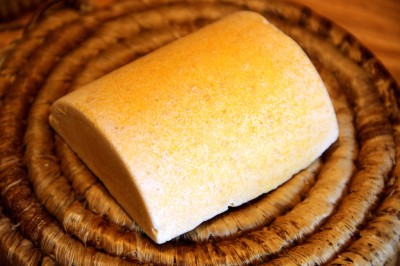
What is a salt bar?
A salt bar is typically a soap made with 50-100% of oil weight in salt. For example, if your salt bar recipe contains 32 oz. of coconut oil and 8 oz. of castor oil, then you would use 20 – 40 oz. of sea salt.
Why on earth would we want to make a salt bar?
- Sea salt is purifying, drawing and acts as an astringent. It is great, especially, for acne.
- Salt bars last FOREVER in the shower. In my experience, they last longer than regular bar soap. (This is a great selling point.)
- Salt bars are hard! Salt soap cures out super hard. Salt bars are great for individual cavity molds that you can’t usually use with your regular recipe. The soap gets hard fast and will pop right out.
- They are inexpensive to make. Salt bars contain mostly coconut oil (a cheaper oil than say…olive oil or shea butter) and sea salt, thus creating a pretty inexpensive bar of soap.
- They are easily marketed as spa type or facial bars of soap. Customer love to hear about the benefits of sea salt and will pay more money for these special bars of soap.
Base Oils – Coconut Oil
Salt bars usually contain a high amount of coconut oil. You can use 80-100% coconut oil.
Why so much coconut oil?
Salt is a lather killer! It kills the suds. To combat the lather killing effects of salt, we use a high amount of coconut oil.
Some typical oil combinations include:
- 100% coconut oil
- 80% coconut oil + 10% butter + 10% liquid oil
- 90% coconut oil + 10% butter
- 90% coconut oil + 10% liquid oil
Liquid oils can be any liquid soapmaking oil…castor oil, olive oil, avocado oil, rice bran oil…whatever your favorite is.
Butters can include shea, cocoa, mango, sal, kokum…or whichever cosmetic butter you prefer.
Superfat – 20%
What do we know about coconut oil in high percentages?
It can be drying. To combat the drying effects of using high coconut oil, we use a high superfat to leave oils unsaponified to make our soap moisturizing and nourishing. A typical superfat for a salt bar is 15-20%. I usually use 20%.
In a recipe not containing salt, this might make our soap mooshy or soft. But not in a salt bar. The salt helps to harden the soap. Even using a high superfat of 20%, this soap turns out super hard.
Salt – Which to use?
There are many different types of salt. Most any type of salt will work except dead sea salt. My favorite salt to use is fine sea salt. I get mine from Wholesale Supplies Plus.
Dead sea salt is actually more mineral than salt. It makes for a weepy, wet and yucky salt bar. Check out Amy’s post where she learned the hard way.
I don’t use Epson salt either. I’m not sure if that works or not…
Size doesn’t really matter. I prefer fine grain, but you can use up to large grain. It all melts with the warm water so isn’t that scratchy or exfoliating.
For varied color, you can use pink salt. I love this pink sea salt from Bramble Berry.
How much salt do you use?
You can use anywhere from 50% – 100% of your oil weight in salt.
Individual Cavity Molds
Salt bars get hard fast! It is best to use individual cavity molds when making salt bars. My favorite mold for salt bars this mold from Bramble Berry. I love the way the half cylinder bars fit in my hand.
If you pour salt soap into a loaf mold, you have to monitor it closely and cut it before it gets to hard. This can be 4 hours after you pour or 8. Sometimes it is hard to tell when they are ready to cut.
Let’s formulate a salt bar recipe!
Step 1 – How much soap will your molds hold?
I’m going to use the above Bramble Berry molds for this example. I want to fill up two of the molds. Each cavity holds 4 oz. for a total of 48 oz. of soap (oils + water + lye + salt). There is no easy formula to determine your oil amount because everyone uses a different amount of salt; some use 50%, some use 100%.
Step 2 – Formulate your base oils.
Let’s take a shot in the dark and start with a recipe that uses 24 oz. of coconut oil. Plug 24 oz. of coconut oil into soapcalc.net with a 20% superfat. For water, I ignore soap calc and when formulating salt bars, I simply multiply the lye amount by 3. So we end up with a recipe of :
- Coconut oil – 24 oz.
- Lye – 3.4
- Water – 10.5
Step 3 – Determine how much salt you want to use.
Let’s see what it looks like with 50% salt and 100% salt.
- 50% Salt Bar
- Coconut oil – 24 oz.
- Lye – 3.4 oz.
- Water – 10.5 oz.
- Salt – 12 oz.
- Total oz. (49.9 oz.)
- 100% Salt Bar
- Coconut oil – 24 oz.
- Lye – 3.4 oz.
- Water – 10.5 oz.
- Salt – 24 oz.
- Total oz. (61.9 oz.)
Since our molds will hold 48 oz. of soap, the 50% salt bar will fit nicely. If we want to use 100% salt, we will need to scale the recipe down.
- 100% Salt Bar
- Coconut oil – 19 oz.
- Lye – 2.7 oz.
- Water – 8.1 oz.
- Salt – 19 oz.
- Total oz. (48.8 oz.)
This 100% salt soap will fit in our molds.
Step 4 – Fragrance or Essential Oil
I calculate my rates based on the amount of oil in my recipe. For salt bars, I calculate based on the amount of oil + salt.
My standard rate for fragrance oil is .7-1 oz per pound of oil + salt. My standard rate for essential oil is .5 oz per pound of oil + salt. Rates vary depending on the strength of your oils, but these are good starting off points.
- 100% Salt Bar with fragrance oil at 1 oz. per pound of oil + salt
- Coconut oil – 19 oz.
- Lye – 2.7 oz.
- Water – 8.1 oz.
- Salt – 19 oz.
- Total oil + salt = 40.7 oz.
- FORMULA 40.7 / 16
- Fragrance oil = 2.5 oz.
- 100% Salt Bar with essential oil at .5 oz. per pound of oil + salt
- Coconut oil – 19 oz.
- Lye – 2.7 oz.
- Water – 8.1 oz.
- Salt – 19 oz.
- Total oil + salt = 40.7 oz.
- FORMULA (40.7 / 16) * .5
- Essential oil = 1.27 oz. (round to 1.3 oz.)
Step 5 – Add your colorant.
Most of the time colorants are simply a matter of preference. You can start with adding 1 teaspoon per pound of oils of mica, pigment or natural colorant and go up from there based on the color that you are trying to get.
So in the above example, you would add 2.5 teaspoons of a colorant and see how it looks. Adjust if more is needed to achieve the color that you want.
Our Final Recipe:
- 100% Salt Bar with essential oil
- Coconut oil – 19 oz.
- Lye – 2.7 oz.
- Water – 8.1 oz.
- Salt – 19 oz.
- Essential oil = 1.3 oz.
Equipment Needed
Digital scale
Containers for measuring & mixing lye solution
Container for mixing soap
Spatula or spoon
Individual Cavity Molds
Salt Bar Process
Step 1 – Wearing safety gear, make your lye solution by weighing out the lye and water into separate containers. Sprinkle the lye into the water while stirring. Stir until dissolved and set aside to cool.
Step 2 – Weigh out coconut oil and melt.
Step 3 – Add the essential oils, additives and colorant to the melted coconut oil. Stir.
Step 4 – Check the temperatures of your lye solution and oil mixture. Each should be under 90 degrees F. If not, let cool a bit longer.
Step 5 – While stirring the oil mixture (with stickblender off), pour lye solution into the oils.
Step 6 – Using short bursts with your stickblender, mix until light trace has occurred.
Step 7 – Mix in fine sea salt. Mix well. Pour the soap into your molds.
Step 8 – Allow to sit and harden. You can usually unmold salt bars the same day. Allow to cure for a minimum of 4 weeks.
Enjoy your salt bars!
I hope this helps you when you formulate your own salt bars! If you have any questions, post in the comments.
Happy Soaping!
Amanda Gail
[/fusion_builder_column][/fusion_builder_row][/fusion_builder_container]
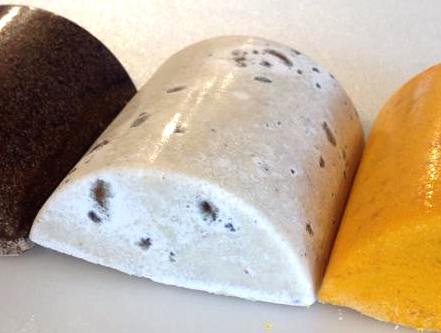
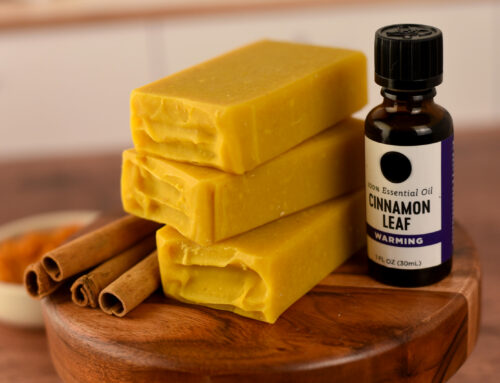
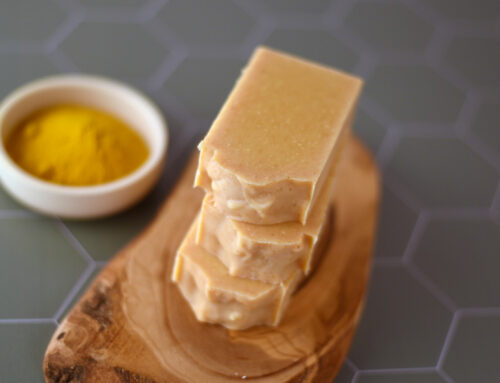
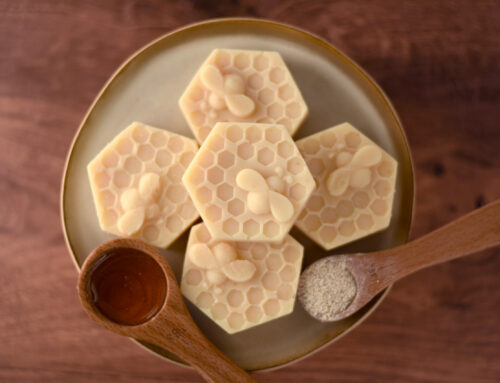


Dear Amanda,
Thank you for sharing the recipies and helping with advices. I wanted to create the sea salt bar by adding salt to lye using your recipe. I also added 10% of sand for exfoliation purpose at the light trace. I made two batches the first batch has 15% of salt (out of all oils) and the second time I added less 10% . Both time the soaps were crunchy (less salty car is less) on the edges while cutting after 4 hours in mould. The both bars are crumbly and chalky (still 2 weeks to cure). I wonder if i need to add much less salt when making sea salt lye solution to avoid the crunching.
Hi Amanda,
I just made a pumpkin coconut milk salt bar and mistakenly used a SF of 29%. Will that be okay to use on my skin and will it make soap. It looks amazing and within a few hours it hardened. Just a little apprehensive because the highest SF I’ve used is 20 on salt bars. I guess it will be an experience. 😳 I used 70 percent CO
13 percent avocado and 17 Shea with 9.5 ounces of Himalayan pink salt to formulate my bars.
Your input will be greatly appreciated.
Thanks.
Greetings! I know this is an old pose. I have a question, but first I want to say that I love how you talk us through how to formulate our own salt bars! Thank you so much.
I did a 90% coconut oil to 10% shea, salt at only 50% weight of the oils, poured into individual molds with a swirl of spirulina.
They’ve been curing for a couple of weeks and have developed a film of salt on top. How can I avoid that? I saw some folk in the comments suggesting dissolving the salt in the lye solution first. Would that be a good work around? I kind of like the idea of getting a gentle exfoliate from the undissolved salt, but I’ll trade that out for bars without the white layer on top.
Are you sure it’s not soda ash? CP soaps get this all the time, most soapers will spritz the finished soap with isopropyl alcohol to prevent soda ash if they mind it. You can simply wash or plane it off after it’s done curing. It’s harmless, just a cosmetic nuisance.
I finally got around to reading all of this and followed directions using soapcalc.net. However, I get different results and don’t know why or what settings I have or have not reset properly. I put in 24 oz co and changed the superfat to 20%. But when I calculate, I get 3.52 oz of lye. Multiply 3.52 x 3= 10.56 for water. Your instructions state that when you calculate lye, you get 3.4. If you multiply that by 3 you get 10.2. What am I missing? Where does the 10.5 water come from? Please advise. I’m very anxious to make salt bars. 🙂
I never heard of you but have followed Amanda and her husband’s advice since I started making soap. So there was no need for you to say this about her. However, if you have some constructive criticism, fine, add it, we all like to learn, and this is a collective effort.
I have loved using this salt bar recipe for the past year. Recently, a fellow soapmaker advised me that this is more water than I really need. Can you advise on that?
You must have at least as much water as lye. That’s the only amount of water that is actually NEEDED in any soap recipe. Beyond that it’s a personal choice, typically determined by how intricate your design is/ isn’t, your skill and comfort level working with thicker trace, your recipe and so on. A 3:1 ratio is safe for any skill level but will take longer to fully cure than say a 2:1 ratio. I would suggest you make a few small batches and experiment with different water amounts to see the different ways they perform and what you’re comfortable with. It’s important to know that Salt bars will perform differently (I mean the batter) than regular soap batches, and you’ll likely prefer at least 1:2 or 1:2.5 for ease of making and pouring. (*using excessive of water will cause glycerin rivers)
Good morning, I followed this recipe and my soap turned out oily and grainy, like a salt scrub. What did I do wrong? Also Can I swap some of the coconut oil out fot anything?
100% Salt Bar with fragrance oil at 1 oz. per pound of oil + salt
Coconut oil – 19 oz.
Lye – 2.7 oz.
Water – 8.1 oz.
Salt – 19 oz.
Total oil + salt = 40.7 oz.
FORMULA 40.7 / 16
Fragrance oil = 2.5 oz.
Hi! I just wanted to inform everyone that the link at the top of the page to click on about how salt helps your skin,
will take you to some foreign website that is very inappropriate! Do not suggest clicking on it! I’m sure she has not
been made aware of the fact, or she would have investigated it further.
« For water, I ignore soap calc and when formulating salt bars, I simply multiply the lye amount by 3. » this is a huge incompetence. There is no reason to use so much water, trust me. This blogger doesn’t know what she’s talking about:/
I never heard of you but have followed Amanda and her husband’s advice since I started making soap. So there was no need for you to say this about her. However, if you have some constructive criticism, fine, add it, we all like to learn, and this is a collective effort.
Dear judgemental,
Yes you can certainly use less water, but there‘a nothing wrong with a 3:1 ratio! When I first began making CP soap the recipes were mostly 3:1 because it’s easier for novice/ beginner soap makers. You are welcome to use a 2:1 or a 1:1 ratio, do whatever you want. But don’t insult and name call the creator just because she chose to consider everyone who might make these bars, and not just you. And please attach a link to your website so we can try out some of your soap recipes. I’m assuming we’ll find nothing to complain about, as you know better than everyone.
Iam really sorry to say, but the lye and salt ratio 1:3 is really bad advice, after 24 hours my salt soap is still squeeshy. I will not trust this bog anymore.” I ignore soap calc and when formulating salt bars, I simply multiply the lye amount by 3.” Thats really a way too much water!!! Conclusion: Don’t trust this soap blogger anymore!
It’s the water to lye ratio of 3:1, not salt. Salt bars harden so fast that increasing the water to this ratio makes sense. I did run the formula of 24 oz CO at 20% superfat, through soapcalc at a 3:1 ratio and the numbers calculate out. Even without manually entering in water to lye ratios, the default settings on soapcalc (38% water of oils) shows the water for this particular formula being 9.12 oz, 1.43 oz less that what’s written above. Hardly material.
Many ‘bloggers’ list a range of water to lye ratios of 1.5:1 to the upper limit of 3:1 so this particular post is not unusual. The oils to salt calculation is between 1:.5 to 1:1 of the weight of the oils. With that calculation combined with the full water recommendation the batter will be thick but still fluid enough to pour into individual cavity molds and should still be ready to unmold in 1/2 the time of regular cp soap. Really no need for back to back comments on a 6 year old post.
I agree with you. I’ve been using the 3:1 water to lye ratio for years and my bars have zero problem hardening up. My salt bars using this formula are by far my best sellers. No need for harsh words against Amanda really.
So you’re just awful.
Is it normal for these bars to have a white film/texture?
I didn’t notice it on my white batch but with this gingerbread brown one is very noticeable.
It’s not soda ash, as i steamed and wiped down and it came right back.
I know this is a year later, but I found the same thing. I’m wondering if we should dissolve the salt in the lye solution.
Did you happen to find a workaround?
If it’s not soda ash then it’s probably salt that’s been pulled to the surface as a result of shrinkage as the bar cures. You could plane it off perhaps, or when you make your next batch just pour a small layer of soap into your molds before you’ve add the salt. It shouldn’t take long to setup so when you pour the remaining batter in it will give you a small layered effect and hopefully a nice, smooth surface!
Hi Amanda
Thank you for your recipe and the explanation. I did a CP but used Dead Sea salt and my super fat was 20%. Put 50% of salt but my bars are still soft after 24 hours!
I put them in flower molds but they did not get in a gel stage. Would I have to throw them out? They look so nice!
You can’t use Dead Sea Salt, it’ll be watery and mushy. (Dead Sea Salt actually melts in the right climate! It’s wild) Use regular sea salt, Himalayan sea salt…just not Dead Sea salt.
Hi, can you please explain the water discount please
I don’t understand the paragraph we’re you “ignore the water” and multiply your lye by 3. Please explain further. Thank you
Amanda, thank you for sharing your expertise & knowledge. Yesterday, I made Fluid HP salt bars (80% Coconut Oil 76 degree, 10% Olive Oil, 10% Castor Oil) and folded in after the cook an appropriate (in my opinion) amount of sea salt that I had pre-powdered using my coffee grinder. Now, at a soapmaker forum, I’ve seen this:
“If you search the forum for salt bars and even read all through this thread you will find we tell people to Never Never grind salt, it can and will cause sharp shards that can lacerate the skin. I highly recommend you do not use those bars directly on your skin. Please heed our experience so you do not end up with a nasty laceration. At best, even some fine grind salt can cause a prickly bar or overly scrubby…”
In your opinion, will powdered salt included in a salt bar indeed do this?
Just wondering, does this bar leave the skin feeling moisturizer? Also does this bar have much lather and bubbles?
Thanks, I really enjoy reading your blog!
Hi Amanda, this is Dewi from Indonesia. I found you are a great tutor. I just finished doing my last log of soap making, and I did sea salt soap based on your tutorial. Everything goes well only the soaps are weeping even after two days, but nicely hard though. How much longer will it take until they are all dry up. Thank you again and have a good day..
Did you use sea salt or Dead Sea salt? Dead Sea salt is a weird one and will weep, seep, and be a soggy mess. Don’t throw them out though, you can toss a bar in your bathtub or foot bath and still reap some of those luxury benefits!
I have a lot of dentric sakt in hand right now, could I use this type of salt or would it be best to just wait for my five grain sea salt to arrive? Also, I was wondering if a 25% SF would be too much?
Can I use goats milk in place of the water in a salt bar?
Another really great option for salt soap bars is divided slab molds like this one – or even single cavity molds where each mold holds one bar of soap.
Big thanks for sharing this! So clear and action-appetizing. I was wondering – is it necessary to use a stick blender for this recipe? I know it’s a must have for soap making, but as it’s not on the equipment list and only comes in short bursts in the mixing 😀 I just feel like double checking. Thanks again
On the Soap Making Facebook page, everyone told me that the salt had to be dissolved in water before adding the lye. They said it wouldn’t harden the soap bar properly if added after the oils and lye were mixed. I added a teaspoon of salt per pound of oils to two different batches after the lye and oils had been combined, just as in your recipe above, to harden my bars. In both batches, the soap batter thickened to the consistency of room temperature butter almost immediately after adding the salt. It was hard to glop it into the molds fast enough, and I ended up with huge air pockets that no amount of tapping the molds could get out. Any thoughts?
Hello Amanda,
I want to make facial soap but i never made any soap salt bars…
If i made 50% of salt for soap salts recipe, can i add other ingredient like activated charcoal or bentonite clay?
thank q
Yes you most certainly can and those would be lovely additives for a facial bar! I suggest going to SoapQueen.com where they have some detailed recipes like this. Unfortunately the author here doesn’t answer anyone’s questions and I don’t feel comfortable advising you how to make these, as it would be quite difficult to ask me any follow ups questions you may have. Good luck!
Hi Amanda. I’m new to soapmaking (4th batch) and I just made your salt soap recipe. I added ground lavender and oatmeal, only less than a half ounce total. I used a bar mold, against your recommendation, because I recently made it myself and was dying to use it. and also fine Himalayan salt, which I just read was not a good choice. when I cut it after 7 hours, it crumbled pretty badly. Is there anyway I can re do? Reheat and repour? Also, it did not get real thick as you said it would. It poured kind of thin.
Thank you for any advice.
Just wondering. Using 50-100% of oil weight in salt…does that literally mean JUST oil weight, or does that include butters too? Thanks.
Oils and butters.
Hi Amanda, I made a batch with Himalayan Pink Salt a month back and the bars are still dripping water! Why does this happen? Does the climate have anything to do with this? I live in Kerala, India where the normal temperature is between 28 degree Celsius to 32C.
Himalayan pink salt isn’t good for salt bars, they will weep. Table salt or fine sea salt is ideal!
hi there, just wondering how many regular bars of soap your final recipe makes? Also, I’m waiting for my individual molds and was hoping to try this recipe before they arrive via post. I heard 1 litre milk containers work as soap molds. I read you’re not a fan of log molds but if I were to use it just for a test batch, what recipe/ratio of coconut oil and salt would you recommend (to best avoid the crumbling).
Thanks in advance!
Alana
Thank you so much for breaking down the math! It was like the clouds parted and the sun was shining
Hello Amanda 🙂
I really appreciate this..salt calculation seem so complicated. I have a question~
I have 24 oz trays as well (24 bars), I would like to make the 100 coconut oil to 50 salt recipe. To that I would like to add 4 oz fragrance (that may seem high but, my family likes a strong fragrance) Also two tablespoons of poppy seeds. I want to make 4 trays at once with no left over (waste). What would be the recipe please? I’ve been trying to work it out all day! *Feeling frustrated* Thank you.
Hi Amanda,
Thank you for sharing this.
This morning I made the exact size batch as you did and it is almost 9pm and my bars are still soft. I tried unfolding one and it came apart and is still wet feeling.
Any ideas what I could have done wrong?
Hi Sara! Exactly what kind of salt did you use?
I used sea salt. Not dead Sea salt.
I did replace one ounce of the coconut oil with caster oil. Do you think that could be the issue?
Some FB groups I’m in have suggested that I should have discounted the water.
Hi Sara! Replacing an ounce for an ounce shouldn’t make a difference. I honestly don’t know the issue. I make these all the time and they come out rock hard. How are they today?
They are much harder today. I was able to get them out of the mold without breaking apart. I think I was just jumping the gun. I always hear salt bars harden so fast so I thought 8hrs would be enough but I guess I should have waited longer.
Thanks for your help and the awesome blog!
Hi!
I want to do the 80/10/10 recipe. My questions is for the liquid oils do I have to use 10% of the same oil or can I use two different liquid oils? I want to do 5% olive oil and 5% castor oil (which would total the 10% liquid)
Thanks in advance
Hello! yes, you can mix and match oils to get the full 10%.
Good day all. I want to go into soap production after goin through your blog I got some information which can help me improve on my soap making.but I want to ask
(1) What can I add to my soap to increase the quantity of the soap.
(2) what kind of salt can I use to harden my soap?like kind I add normal Hcl salt we use at home.
(3) what is the best foaming agent I can use to increase the lather.
Thank as I wait for you response.
So which oil is your superfat in the final recipe? I just see coconut oil. Am I missing something? Thanks for the very simple and clear directions!
I don’t know if you got a reply, but superfatting can be done through the SoapCalc. Technically, it’s the reduction of lye. So set your super fat percentage in the SoapCalc first at 5% and look at the amount of lye in the recipe, then change the super fat % to 20 and look at the new amount of lye. I had the same question until I figured it out through SoapCalc.
Since the bars harden so fast do you cover and insulate after poring?
No need to cover and insulate. 🙂
Hey Amanda,
This is an AWESOME tutorial – thanks so much!!
You are welcome! Glad you enjoyed it. 🙂
Hi there!
If I were to use a wooden rectangular mold, what size would you recommend? (2lbs, 3lbs, etc).
Thanks!
Jenalle
I really wouldn’t use a log mold for salt bars… But if you really wanted to, I would make 2 lbs. You run the risk of them getting too hard that they are crumbly when cutting.
Hello,
Thanks so much for your post
I have been doing the salt bars for a year now and I encounter a problem with the bars sweating after cure. Can you help me, maybe there is a way to keep them from sweating cause the salt absorbs water.
Thank you
hi amanda, can i use water discount for salt soap? for example 40% lye concentration. thanks
Amanda, I am interested in making a few batches of salt bar soap and was a little concerned after reading Soapmaking 101 about how quickly this can set up. I too have two Bramble Berry molds, the 9 bar cube and the 12 bar squares, how fast is fast? Is there enough time to get the soap into the individual cavities? Thanks!
There should be time to stir and pour. Be sure to soap cool; let the coconut oil cool down to room temp without going solid. I use individual molds all of the time and have enough time to pour. Let me know how it goes!
Will do, thanks!
How long until this soap is not zappy? I followed the recipe and instructions to a t, and HOLY ZAP! Any thoughts?
Hi Amy! It shouldn’t be zappy after about 48 hours. It has a pretty high superfat (20%) so there is room for error. How long has it been?
Phew! I’ll be more patient! It’s only been a little over 24.
Thanks for responding so quickly!
Thanks for sharing this! This is so awesome and informative. Your final recipes sounds awesome and thanks for the mold and salt recommendation shout-out.
Great post! I have greatly enjoyed my first salt bars and can’t wait to make more. Thanks for the info!